Making Waves with Radar
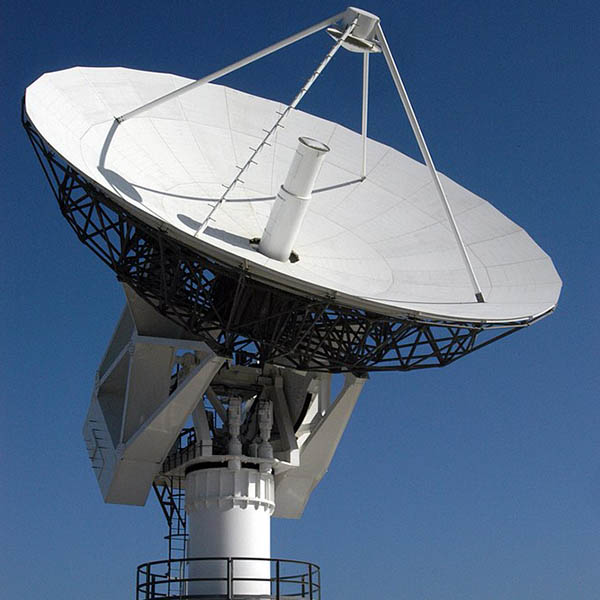
C-band radar (NASA, Wikimedia Commons)

C-band radar (NASA, Wikimedia Commons)
How does this align with my curriculum?
Learn about how the radar works, the history and its many real life applications.
Have you ever been in a cave or an empty room and shouted loudly? If so, you probably heard an echo of your voice. Echoes happen when sound waves reflect off objects, like the walls of a cave. The farther you stand from the wall, the longer it takes for your voice to echo back. If you knew how long the sound took to reflect, and the speed of sound, you would know how far the wall was away from you.
This is similar to how radar works. But instead of sound waves, radar uses radio waves to detect the location of objects. Radio waves are at the low energy end of the .
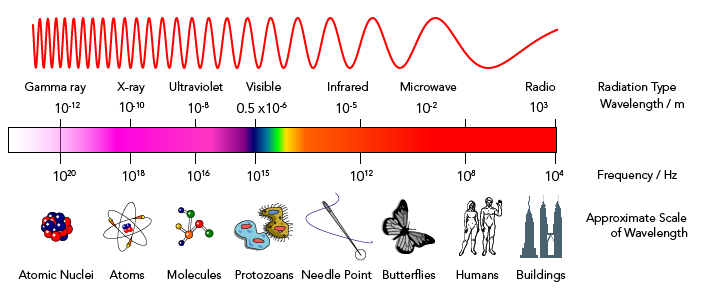
Image - Text Version
Shown is a diagram of a colourful scale with three rows stacked atop each other. Starting from the top: radiation type, frequency and approximate scale of wavelength at the bottom. The red wavelength at the top is more compressed on the left (gamma rays) and gradually stretches out to the right as wavelength increases (radio waves). Frequency decreases from left to right. Photo examples are shown on the bottom row with atomic nuclei on the left and a building to the right.
Radar is used in many different ways. At airports, air-traffic controllers use radar to keep track of airplanes and direct them onto their flight paths. Weather forecasters use radar to predict weather conditions and locate severe weather systems like hurricanes.
How it Works
A radar system is made up of five main parts. These are the transmitter, antenna, duplexer, receiver and display.
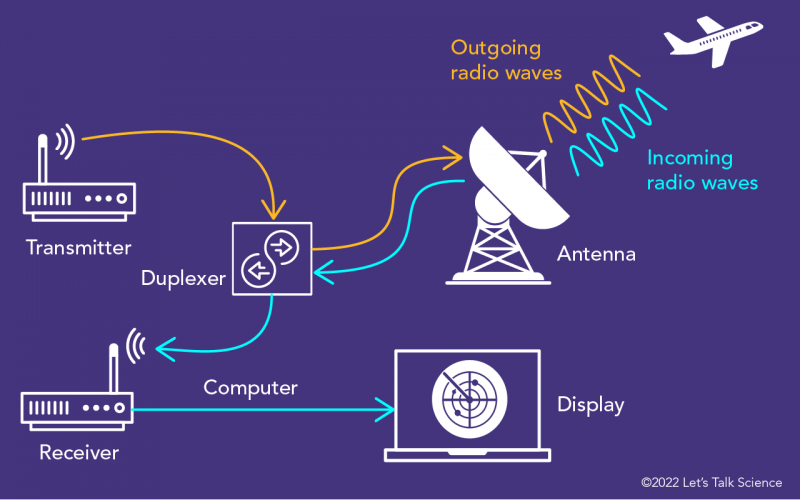
Image - Text Version
Shown is an infographic of the parts and flow of a radar system. Clipart and text are in white on a blue background. On the left-hand side is a transmitter (top) and receiver (bottom). A signal moves from the transmitter, indicated by orange arrows to a Duplexer, then over to the Antenna. Wavy orange lines indicate waves being transmitted. Incoming waves, indicated by wavy blue lines, are received by the antenna. The signal, indicated with blue arrows, is then sent back to the duplexer and on to the receiver. From there the signal is processed by a computer and sent to a display monitor.
- The transmitter uses a magnetron to produce short pulses of radio waves.
- The antenna sends or transmits the waves out into the air. When the waves hit an object, they reflect, or bounce back, to the same antenna. The antenna picks up reflected waves during breaks or pauses between transmissions.
- Because the antenna has the job of both sending and receiving radio waves, radars have a part called a duplexer. A duplexer helps to switch the antenna back and forth between transmitting and receiving. Just as you pause to listen to your voice echo back after you shout something in a cave, radars have to do the same thing.
- Information from the antenna is sent to the receiver. A computer in the receiver processes the reflected waves to make sense of them. By measuring how long it takes the waves to return, the receiver can tell how far away the object is. The receiver can also identify how fast an object is moving and where a moving object is headed. Sometimes radars are also able to detect how big the object is. For example, an S-band radar can detect rain drops but not clouds whose droplets are too small.
- The information from the receiver is then shown on a display, or screen, for people to see.
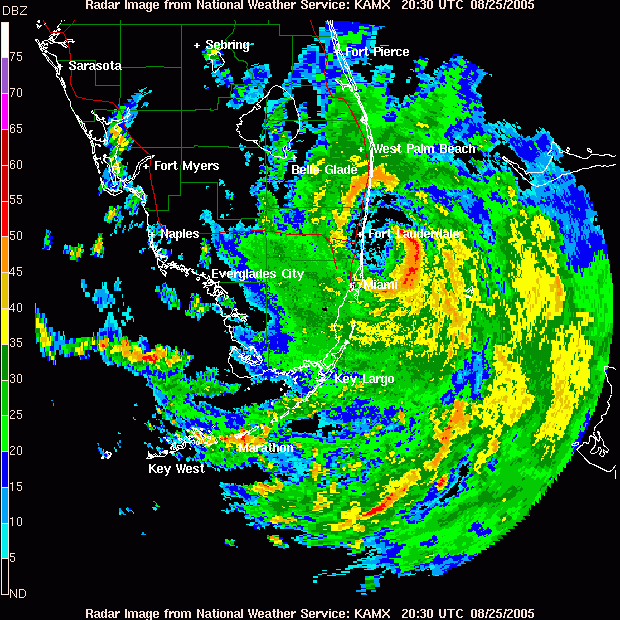
Image - Text Version
Shown is a colourful radar image from 2005 of Hurricane Katrina. It has a spiral pattern of mainly yellow, blue and green patches of colour against a black background. Bits of red can be seen in the eye of the hurricane, as well as the bottom edge of the hurricane. Blue indicates the least precipitation and red indicates the most precipitation. Green, yellow and orange are levels of precipitation in between.
Early Radar
In 1886, Heinrich Hertz discovered that radio waves can be reflected off solid objects. At the time, Hertz could not think of any practical uses for his discovery. Later, in 1897, Alexander Popov discovered that radio waves could be used to detect a ship at sea, but he too didn’t do anything about it.
In 1904, German electrical engineer Christian Hülsmeyer invented a device using radar that he called a Telemobiloskop. He was inspired to invent it when, as a child, he witnessed two ships colliding on a foggy night. He was determined to find a way to prevent similar tragedies that resulted from poor visibility. His Telemobiloskop transmitted radio waves that would reflect off metal objects, like the hulls of ships. He demonstrated his invention to the German Navy, but they were not interested at the time.

Image - Text Version
Shown is a colour illustration of a ship using a telemobiloskop to locate another ship in the fog. The two ships are facing each other. Blue and red dashed lines with arrowheads represent radio waves that are transmitted from the telemobiloskop on the right-hand ship. They reflect off the surface of the left-hand ship back to the telemobiloskop. The cargo ship on the left is covered in a grey cloud to represent fog. The ships are submerged in blue water against a white background.
Although many scientists contributed to the development of radar, best known among them is Scottish physicist Robert Watson-Watt. His radar system was originally designed for Britain's Meteorology Office to help them detect approaching storms.
In 1935, he wrote to the British government explaining how radio waves could be used to detect aircraft. By then he was able to demonstrate that his radar system could locate aircraft consistently at a distance of up to 140 km. The government saw the great potential in this, and by World War II (1939–45), were using his radar system as part of a series of radars called Chain Home. By detecting enemy aircraft, Chain Home radar played an important role in helping Britain, France, and the United States defeat Germany. A similar system was developed at the same time in the United States. The system there was able to detect the approach of Japanese airplanes over Pearl Harbor, in Hawaii, in December 1941. Sadly, no-one figured out the seriousness of so many approaching planes until it was too late.
Did you know?
At the beginning, these systems were not called radar. The word "radar" was an acronym coined in the 1940s by the United States Navy. It stands for radio detection and ranging.
Types of Radar
There are two main types of radar. These are pulse radar and continuous wave (CW) radar.
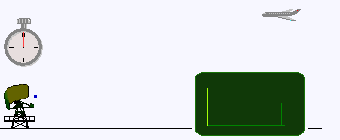
Pulse radar (Source: Averse [CC BY-SA 2.0] via Wikimedia Commons).
Image - Text Version
A colour animated graphic of pulse radar. There is a stop watch on the upper left corner. It shows how long the pulse takes to be sent and reflected. A radar antenna on the lower left sends a signal (blue dot) diagonally across to a grey aircraft in the upper right corner. This is reflected back to the antenna as a light blue ripple. A green graph in the lower right corner tracks the time it takes for the wave to be sent and reflected.
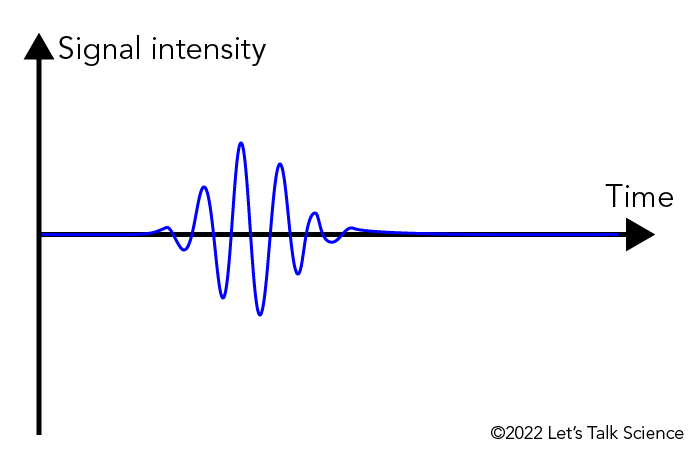
Image - Text Version
Shown is a graph with signal intensity on the vertical axis and time on the horizontal axis. A blue line oscillates up and down in one small section of the graph. The line is horizontal on either side of the oscillation.
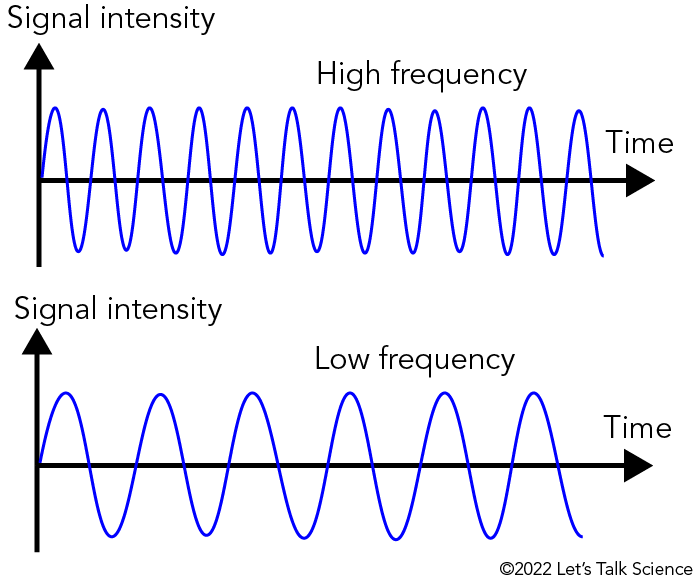
Image - Text Version
Shown are two graphs stacked on top of each other. Signal intensity is on the vertical axis and time is on the horizontal axis. The top graph shows high frequency where the wave pattern (blue) appears more compressed. The bottom graph shows low frequency where the wave pattern (blue) appears more stretched out.
Uses of Radar
Airport Surveillance Radar (ASR)
ASR is a radar system used to detect and show the location of aircraft in the airspace around airports. This is the main Air Traffic Control (ATC) system used around the world. The purpose of ATC is to prevent collisions between aircraft. It does this by showing the location and movement of aircraft so that air traffic controllers can tell them where to go. This system typically controls traffic within a 96 km radius of the airport for aircraft flying below an altitude of 7.62 km (25,000 feet).
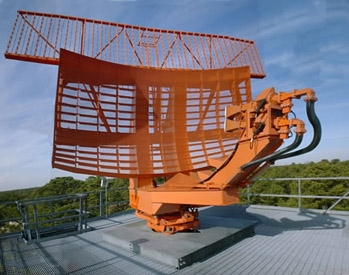
Image - Text Version
Shown is a colour photo of an airport surveillance radar. Seen in the foreground is an orange curved dish (primary radar). A horizontal rectangular metal grid (secondary radar) is attached on top of the dish. The radar system is mounted on a base atop a tower (not seen in the photo). There is grey railing around the perimeter of the radar system. In the background, blue skies, wisps of white clouds and the tops of trees can be seen.
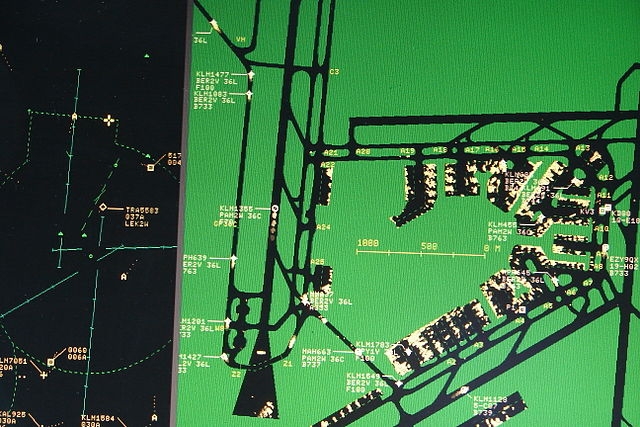
Image - Text Version
Shown is a radar display of traffic at an airport. Runways and taxiways are black and the surrounding land is coloured green. Aircraft appear as small white shapes. Beside these are information about each aircraft including its designation, speed and altitude.
Doppler Weather Radar
Doppler radar is a specific type of radar that uses the Doppler Effect to gather information from a moving object. Doppler effect describes how sound changes as the source of the sound moves towards or away from the receiver.
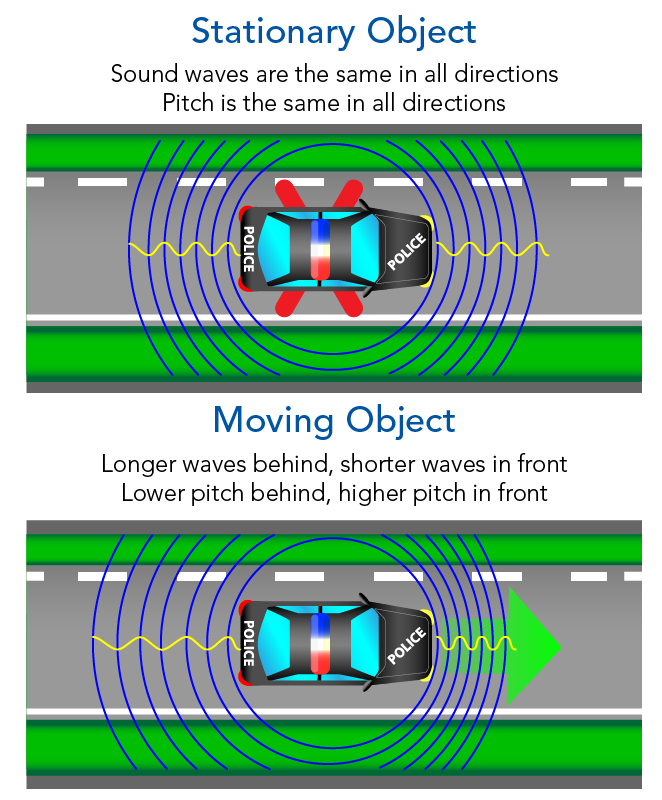
Image - Text Version
Shown is a colour illustration showing the difference in sound waves between a stationary police car vs. a moving police car. The sound waves around the stationary car (top) radiate evenly in all directions. The sound waves around the moving car are closer together in front of the car and further apart behind the car. The direction of motion of the car is indicated with a green arrow which points to the right.
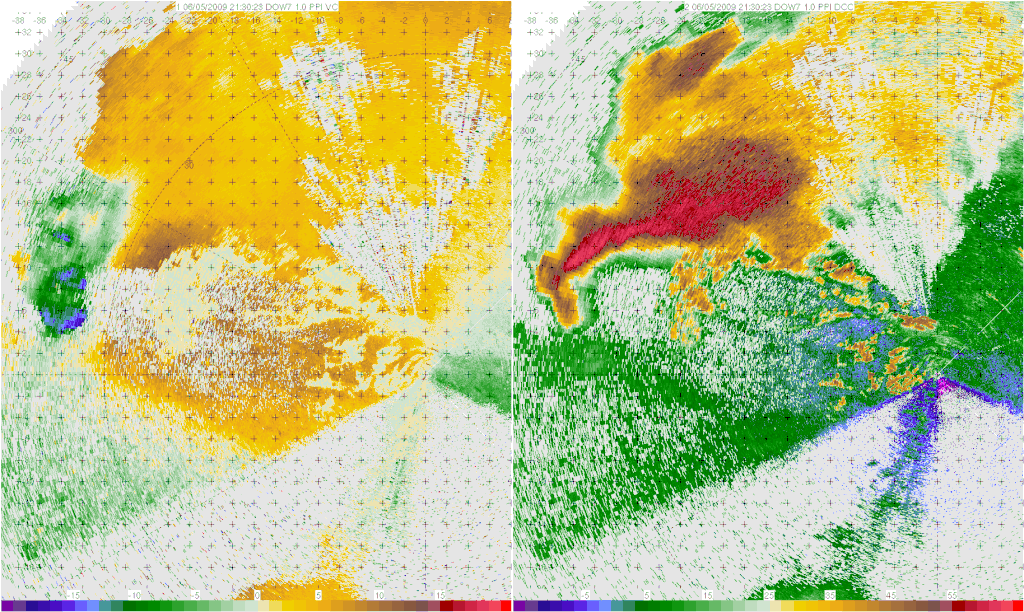
A Doppler on Wheels image of a thunderstorm near La Grange, Wyoming (USA) captured during the VORTEX2 project (Public image domain by Joshua Wurman, Center for Severe Weather Research via Wikimedia Commons).
Image - Text Version
Shown in an animation of a doppler weather display of a thunderstorm. Blues and greens represent winds moving towards the radar, and reds and yellows indicate winds moving away from the radar. The main body of the storm can be seen as a doughnut-like shape moving across the screen.
Air-Borne Radars
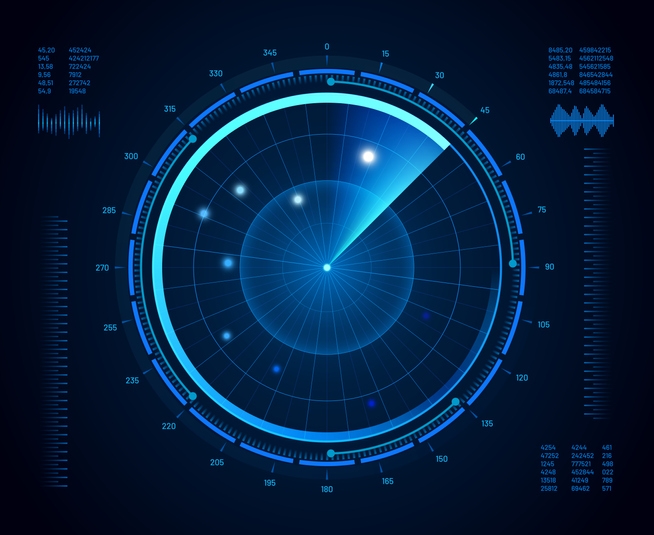
Image - Text Version
Shown is a black and blue coloured image of a search radar display. Numbers can be seen faintly on the outer circumference of the compass-like display. Aircrafts (blue dots) are scattered on the left side of the display. One brighter dot appears on the upper right close to an illuminated area caused by the sweeping radar arm that moves around the display clockwise like the hand of a clock.
Targeting radars work in a similar way, but they scan smaller volumes of space more frequently. They usually scan an area several times a second. Target tracking radars are even more precise. They allow a pilot to target an aircraft using the Missile lock-on. This is a feature of some radars that allows them to automatically follow an object. Once a targeting radar has locked onto a target, the firing system can calculate a path for a missile to the target.
For aircrafts to be able to escape radar detection, they need stealth technology. This can include technology for letting them fly very fast, shapes that reflect radar in unusual ways and radar absorbent materials.
Radar Problems
Radar is very useful, but there are some ways to make it less effective. For example, to confuse the enemy during war time, countries would intentionally send out radio frequency signals filled with noise. This method of blanketing radars with noise is called jamming.
Echos from objects such as land, water, precipitation, animals and even insects can also cause problems for radar systems. The echoes from these objects, known as clutter, make it hard to detect objects of interest. A big part of radar design is reducing the effects of this background clutter without reducing the echoes from target objects.
Finally, sometimes radar signals from other nearby radar systems can be an issue. This type of radar interference is more of a problem for automatic detection and tracking systems. It is less of a problem for trained radar operators who can tell the difference.
More Uses for Radar
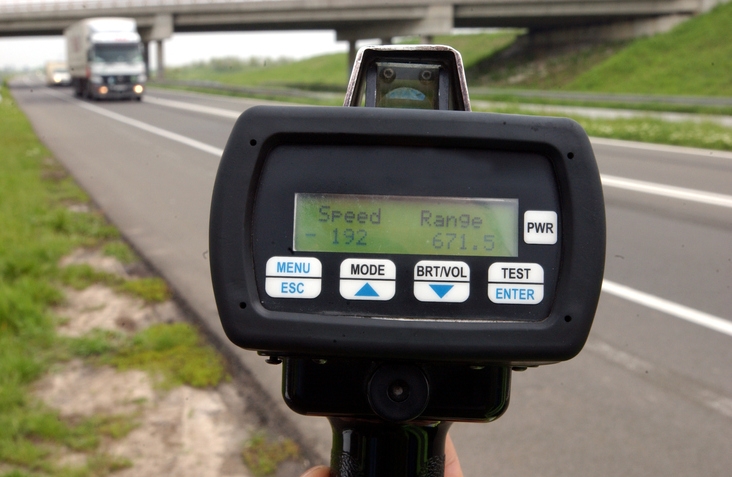
Image - Text Version
Shown is a colour photo of a hand held radar device being used at the side of a highway. In the foreground is the display part of the device and the top of a person's hand. On the display are numbers for the speed and range of an approaching transport truck. A concrete overpass can be seen behind the truck.
Did you know?
In some cases, radar is being replaced with LIDAR. LIDAR stands for LIght Detection And Ranging. It uses pulses of light instead of pulses of radio waves. Scientists also use a form of this visible radar to measure air pollution with lasers.
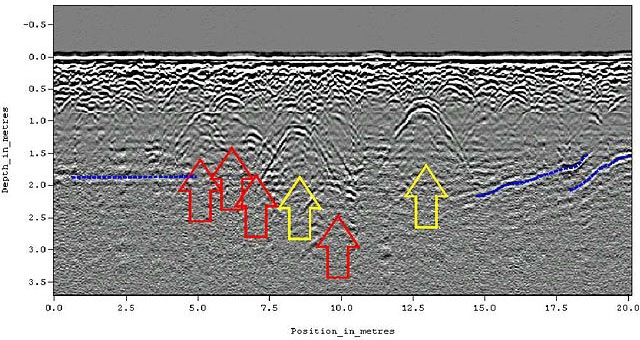
Image - Text Version
Shown is a greyscale image of radar data. Depth measurements are on the vertical axis and position measurements are on the horizontal axis. Several white coloured wavy lines of different sizes are visible. Yellow and red arrows point to these waves. These indicate the possible locations of human remains that reflected the radar signals.
The United States National Aeronautics and Space Administration (NASA) uses radar for many things. They use it to map the Earth and other planets, to track satellites and space debris as well as help with docking and manoeuvring space modules.
With so many practical uses for radar, even Heinrich Hertz would be amazed!
Learn More
What is a radar?
This page from Swiss Airlines has some basic information about how a radar works, along with quizzes and games.
Climate and landscape changes shifting Texas bats’ migration (2018)
Article from the Wildlife Society on how weather radars are used to study the impact of climate and landscape changes on bat migration in Texas.
Ground Penetrating Radar
This story, from Ember Archaeology in Alberta, describes how ground penetrating radar was used to locate possible unmarked graves.
References
Brain, M. (n.d.). How Radar Works. HowStuffWorks.com.
Britannica Kids (n.d.) radar.
Browne, J. (Jun 14, 2018). Pulsed vs. CW Signals: Both Loom on a Designer’s Radar. Microwaves & RF.
Encyclopaedia Britannica (n.d.). Radar: Atmospheric Effects.
Kobilinsky, D. (October 1, 2018). Weather radar helps predict bird migrations. The Wildlife Society.
National Weather Service (n.d.). How Radar Works. National Oceanic and Atmospheric Administration.
New England Historical Society (2022). Percy Spencer Melts a Chocolate Bar, Invents the Microwave.
NOAA National Severe Storms Laboratory (n.d.). Research Tools: Radar. National Oceanic and Atmospheric Administration.
Wolff, C. (n.d.). Air-Defense Radars. Radartutorial.eu.
Woodford, C. (Mar 12, 2021). Radar. Explain That Stuff!